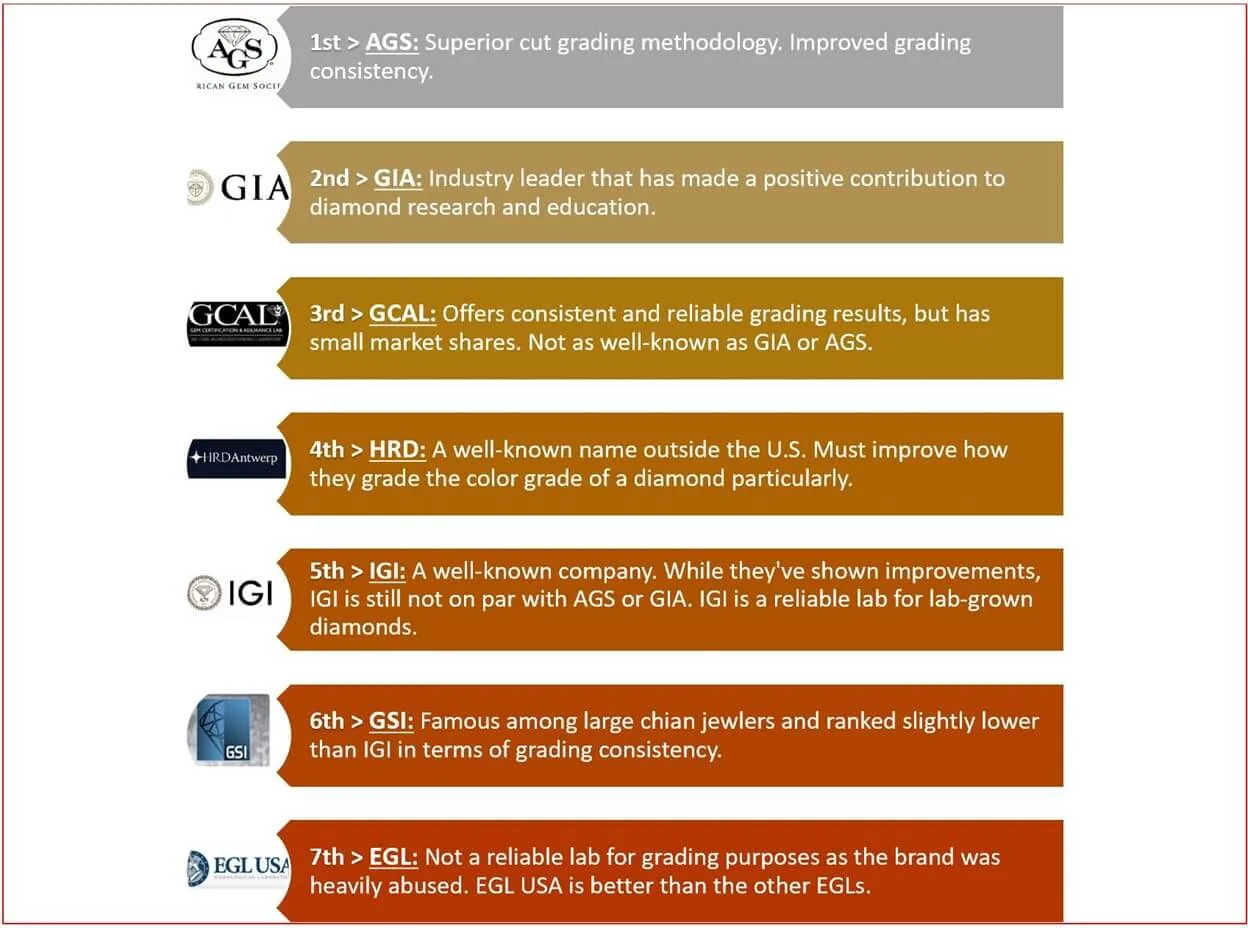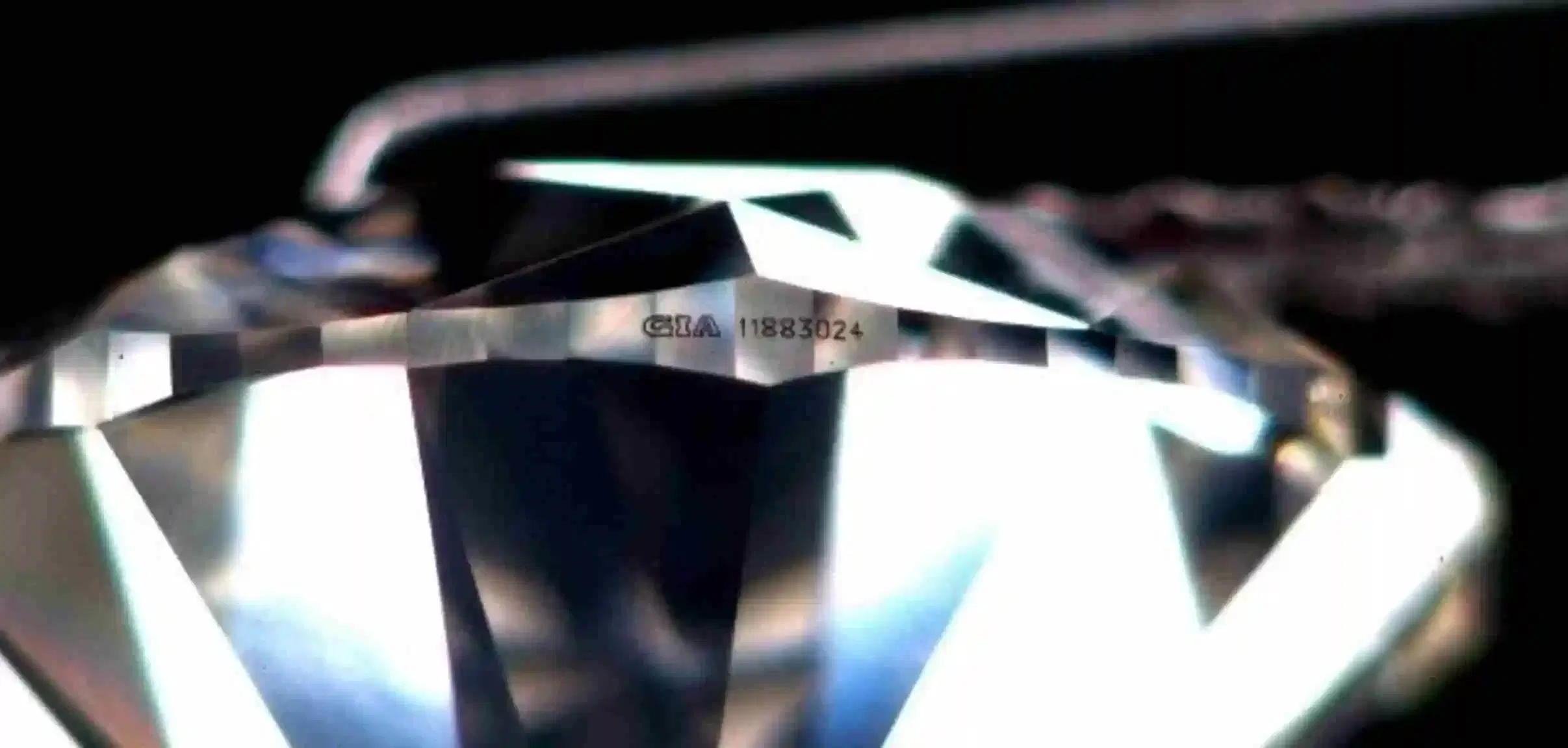Below are our ratings for the best diamond grading labs, along with summarized insights about the shortcomings of each organization.
For reliable grading, the best diamond certificaiton lab is GIA, which is widely regarded as a trustworthy and consistent grading lab. HRD and GCAL are also considered reliable labs. The International Gemological Institute (IGI) has been improving its diamond grading process. However, the European Gemological Laboratory (EGL) has lost credibility and market share due to inconsistencies. The Gemological Science International (GSI) is generally satisfactory, though occasional grade inconsistencies may arise. The Professional Gem Science Laboratory (PGS) is dependable but less known in the market.

AGSL - AGS Certification
The American Gem Society (AGS) functions as a membership organization encompassing jewelers, suppliers, appraisers, and traders. Its inception dates back to 1934. However, its laboratories, the American Gem Society Laboratories (AGSL), were established in 1996. The organization also features an advanced instruments division, founded in 2004.
AGSL is primarily responsible for grading diamonds and has developed its own standards. It is a formidable rival to GIA and has a strong reputation in the diamond industry. Yet, an area of concern arises when AGS grades the clarity of diamonds, particularly in the SI1/SI2 range. Instances have been observed where AGS graded diamonds in the SI2 category as if they were more akin to I1 diamonds. Consequently, caution is advised when dealing with AGS's inconsistencies in grading clarity within the SI2 range.
Please note that AGS merged with GIA in late 2022. These insights are relevant to existing AGS grading reports, which can be verified here.
GIA Certification
The Gemological Institute of America (GIA) is a non-profit organization that researches and educates consumers about jewelry and gemstones. Its involvement encompasses the study and grading of diverse gemstones. Alongside its lab services, GIA offers gemologist training, comprehensive education, and research support to the diamond industry. GIA's diamond grading reports are highly esteemed as the industry's foremost "certifications" and verification documents.
GIA offers two types of diamond grading reports: full reports and diamond dossiers for smaller diamonds. Dossiers are more cost-effective than full reports, yet they lack a diamond's complete plot, omitting the inclusions' precise location. In the case of dossiers, GIA mandates a laser inscription on the diamond, given the absence of inclusion locations. Conversely, full reports offer a different approach. Diamond dealers can include a laser inscription as an additional service within full reports for an additional fee of $30.
However, with GIA's expansion, concerns have arisen regarding the declining quality of its grading services. Instances have emerged where GIA regraded its own G color diamond to a lower H color.
Discussions also revolve around GIA's methodology for determining excellent cuts in diamonds. A point of contention pertains to the broad criteria for assigning excellent cut grades to diamonds – the highest tier on GIA's scale. In comparison, it has been suggested that AGS's utilization of a proportion-based system for assigning ideal cut grades in their reports may yield a superior grading approach. For those considering well-cut GIA graded diamonds, evaluate GIA's report against our recommended super ideal cut proportions.
GIA diamond reports can be verified here.
HRD Certification
HRD Antwerp, closely linked to the Antwerp World Diamond Center, occupies a significant role within the diamond trading and supply sector. Established in 1973, HRD represents the Belgian diamond industry. The HRD Lab adheres to standards akin to those of GIA and follows grading regulations set by the International Diamond Council, underlining its reliability.
Nevertheless, it is worth noting the possibility of grade inconsistencies in HRD's grading process, particularly in relation to diamond color and clarity. This aspect warrants consideration when contemplating the purchase of HRD-graded diamonds.
HRD reports can be verified here.
IGI Certification
Founded in 1975 and headquartered in Antwerp, the International Gemological Institute (IGI) has a global presence with multiple branches and a gemology school. However, IGI's widespread reach translates to slightly varying grading criteria among their labs in different countries. While still a major player, IGI's accuracy is generally considered somewhat lower than GIA or AGS. Anticipating one-grade inconsistencies when purchasing IGI-graded diamonds is common. Recognizing the uniqueness of each diamond, a generalized approach is less effective as individual cases require tailored consideration.
As such, a degree of grading inconsistency across all 4Cs is expected when it comes to IGI's grading. Buyers can verify an IGI-issued report here.
GSI Certification
Gemological Science International (GSI) primarily grades diamonds for large chain stores, focusing on high-volume grading. With a global expansion, GSI's appeal to large stores lies in its ability to offer expedited diamond grading services compared to GIA or AGS. While its accuracy is comparable to IGI in diamond grading, GSI often assigns slightly lower grades than GIA or AGS. Nonetheless, due to the distinct characteristics of each natural diamond, individual evaluation remains crucial.
Opting for GIA or AGS certifications is advisable for those without comprehensive knowledge or the time for exhaustive research.
Prudence is recommended when assessing GSI-graded diamonds, as some grade inconsistency may occur. Seeking the expertise of a third-party expert can be beneficial, considering that the reliability of appraisers can vary. This may entail trade-offs when acquiring GSI-graded diamonds.
GSI reports can be verified here.
EGL Certification
The European Gemological Laboratory (EGL) once held a significant stake in the diamond grading realm. However, its credibility has suffered, resulting in a decline in reputation. EGL is undergoing reorganization, leading to skepticism about relying solely on its reports. Due to its diminished reputation, platforms like RapNet have chosen to exclude EGL-graded diamonds from their platform.
Given the bad reputation, caution is prudent when considering EGL-graded diamonds, particularly those graded from the 1980s to the early 2000s. Even within this time frame, up to two grade inconsistencies in overall grading may be anticipated.
EGL reports can be verified here.



